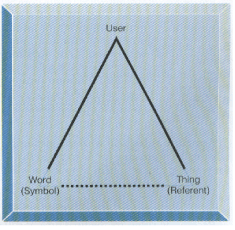Verbal Communication
Learning Units’ Contents
The Nature of Language
When we talk about VERBAL COMMUNICATION our main emphasis will be the LANGUAGE.
Language is the only instrument we have in this type of communicative interaction.
And the first step is always to try to define which is the meaning of this word:
Language.
1 – Language Defined
Language is broadly defined as an ARBITRARY group of symbols.
This definition is rather simple, but in spite of its simplicity, it perfectly reflects what language is.
Still, it may be necessary to explain what symbolic means.
What is a symbol?
Also broadly defined, a symbol an ARBITRARY construction that represents something else, for example an action, but also an object or an idea.
In this way, we have defined the first characteristic of language
1.1 LANGUAGE IS ALWAYS SYMBOLIC
But why are symbols and language ARBITRARY?
Which is the meaning of this adjective?
We talk about arbitrary symbols
because the meaning of these symbols depend always
on the speaker,
or on the audience,
or on the context.
A Language isa living organism in a process of constant change.
And the symbols are themselves something living too – they have their own life – They are not simply labels we use to identifies objects or subjects. Words, the basic type of linguistic symbol, are not necessarily neutral. They act as filters, through which we observe the reality. And these filters can determine the way we perceive that reality.
1.2 LANGUAGE IS RULE-GOVERNED
There are phonological rules
(which deal with the pronuntiation).
There are syntactic rules (which determine how to order the elements of the sentence).
There are
morphologic rules (which explain the function of the words). And
there are finally semantic rules (which deal with the meaning of the words).
Meaning
Symbols in general and words in particular carry a meaning.
But this meaning, contrary to the general opinion, is not in the words or in the symbols we use.
The meaning is in the people who use those words and symbols.
1 – The Triangle of Meaning
The two linguistic theorists C.K. Ogden and J.A. Richards explain this with their TRIANGLE OF MEANING:

This Model shows that there is only an indirect relationship
between the thing (the referent) and the word (or symbol).
And this relationship necessarily goes through the USER of the symbols.
The User gives meaning to the symbols.
For that reason, meanings can be regarded as social constructions.
2 – Types of Words
There two basic types of words:
Concrete words: Symbols for a specific thing that can be pointed to or physically experienced.
Abstract words: Symbols for an idea, quality, or relationship.
3- Types of Meaning
The words, as we already said, always carry a meaning – and likewise we can differentiate two different kinds of meaning:
Denotative Meaning: Primary associations a word has for most members of a given linguistic community.
Simply the specific reference of the word, what we would find if we looked at the dictionary – thus, totally objective.
Connotative Meaning:
Other, secondary associations a word has for one or more members of that community.
This is the personalized definition assigned to the word.
And this personal definition is the result of our experiences, values and culture.
Factors That Influence the Use of Language
A variety of external factors influence the way we speak.
1 – Cultural Influences
Culture, defined as a system of customs, beliefs and attitudes that is common to a racial, religious or social group, determine the way we use the language. We inherit the words from our culture. Still, at the same time, this same culture represents a strong limitation for the use of the language.
2 – Ethnic, Racial and Social Influences
These characteristics determine the words we use, how we express and pronounce theses words, and the meaning that we assign to them.
Of course there is an American culture – and this culture has a language.
But within this culture there are subcultures, too. There are ethnic, racial and social groups
And these groups may have their own slang.
3- Geographic Influences
The region where you grew up determine your accent and your dialect, this is clear, but also the words are used in different sense. The English language spoken in Australia, England, Ireland, or the USA tremendously differ. Even in some regions of the USA the same words are used with different meanings.
Troublesome Language
Language is an instrument for communication, our only instrument in case of verbal communication, a sophisticated tool no doubt, but not always a perfect one.
We have to talk now a little bit about the possible barriers in the process of communication: Barriers that are based in the limitations of language.
We will distinguish three categories in this kind of troublesome language:
- The language of misunderstanding
- The disruptive language
- The evasive language
1 – The Language of Misunderstanding
1.1 Equivocal Words
Equivocal words are those words that have more than one denotative meaning.
The word “aggressive”, for instance, may have opposite meanings (positive or negative) depending on the context.
1.2 Relative Words
These are words that gain meaning by comparison.
This is the case, for instance, of the words we use when we refer to the size or the speed of something.
1.3 Slang
The colloquial language that is used by a certain group.
Slang is effective for identifying outsiders from insiders in a group.
1.4 Jargon
The Jargon also helps the group to identify insiders.
Yet, jargons are strongly specialized. They possess a sophisticated vocabulary that might make communication within a group easier – but impossible if you don’t belong to it!
2 – Disruptive Language
2.1 Confusion of Facts and Opinions.
The opinion always implies a judgment, i.e. a subjective moment.
It is raining (fact)- The weather is bad (opinion).
2.2 Confusion of Facts and Inferences
Inferences are conclusions you arrive at from the interpretation of the facts. For Instance: I see a student yawning in my class. I assume he/she is bored and not interested in the class contents.
Inferences can be right, but you have to identify them as inferences. It is a source of misunderstanding to confuse them with facts. (For instance, the student may have been simple tired because he/she had been working the whole night).
3- Evasive Language
3.1 Euphemism
A euphemism is a pleasant term that replaces another term that couldn’t be so pleasant – euphemisms are not necessarily wrong, you may use them to avoid hurting someone else.
In some cases, however, euphemisms are deliberately misused to distort meaning.
3.2 Equivocation
It is a statement that can be interpreted in several ways, an ambiguous statement.
For example: If your professor asks you how you found the class.
And you found it extremely boring. You wouldn’t say the truth.
You would rather use one of those equivocations, such as “interesting”.
Equivocations are also ambiguous and highly abstract words.
4 Ideographs
Ideographs, as defined by McGee, have the following characteristics:
They are common words, words everybody knows.
These words represent an idea everybody agrees with (Freedom, or Justice).
This idea is a normative goal and presupposes a certain degree of commitment. – That means, it is a standard of behavior. We have to be just or to fight for our freedom.
The idea is extremely vague. Everybody knows the word and everybody agrees with it – meaning, everybody believes that these ideas are good. The problem is that nobody can accurately explain what justice, or freedom is.
